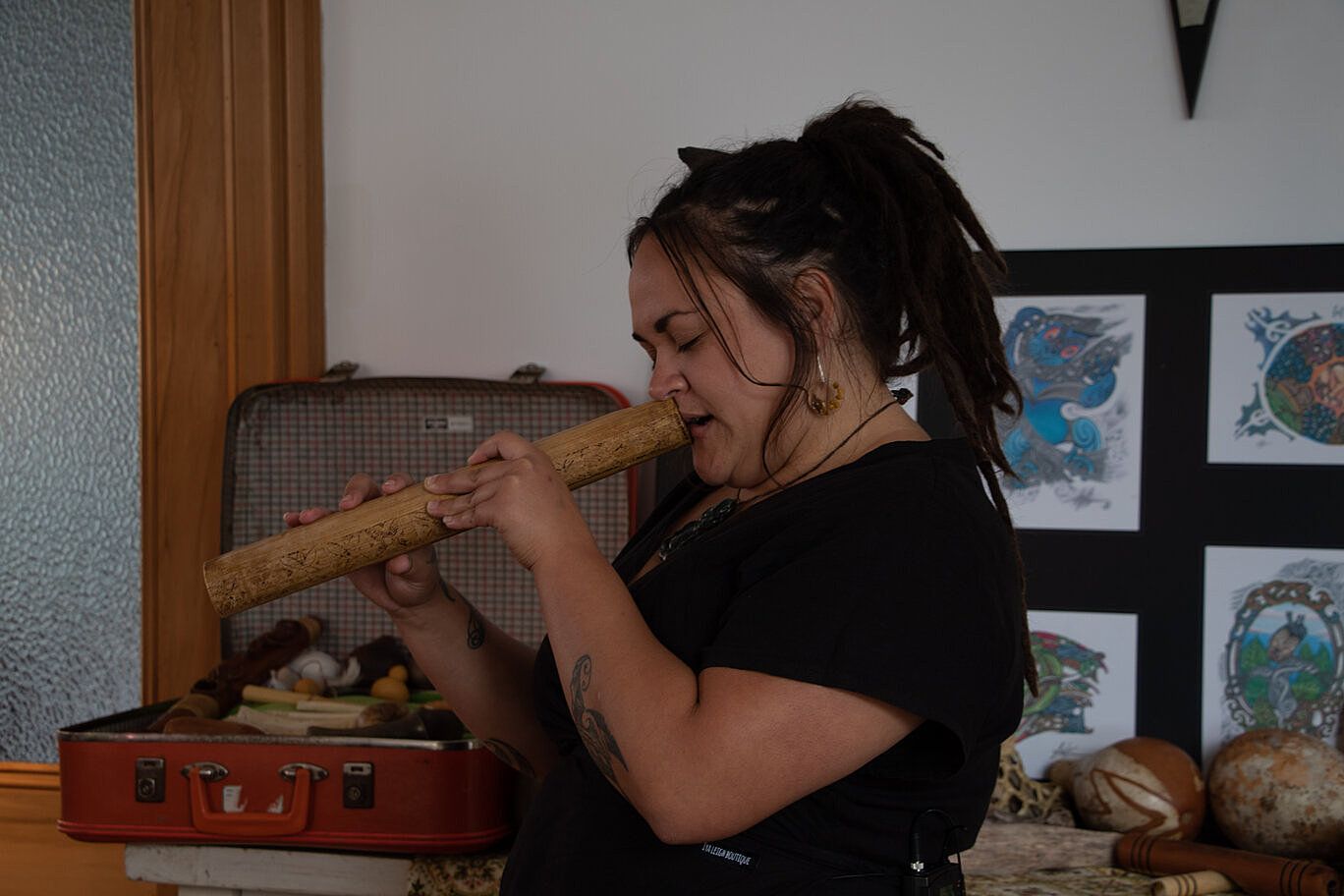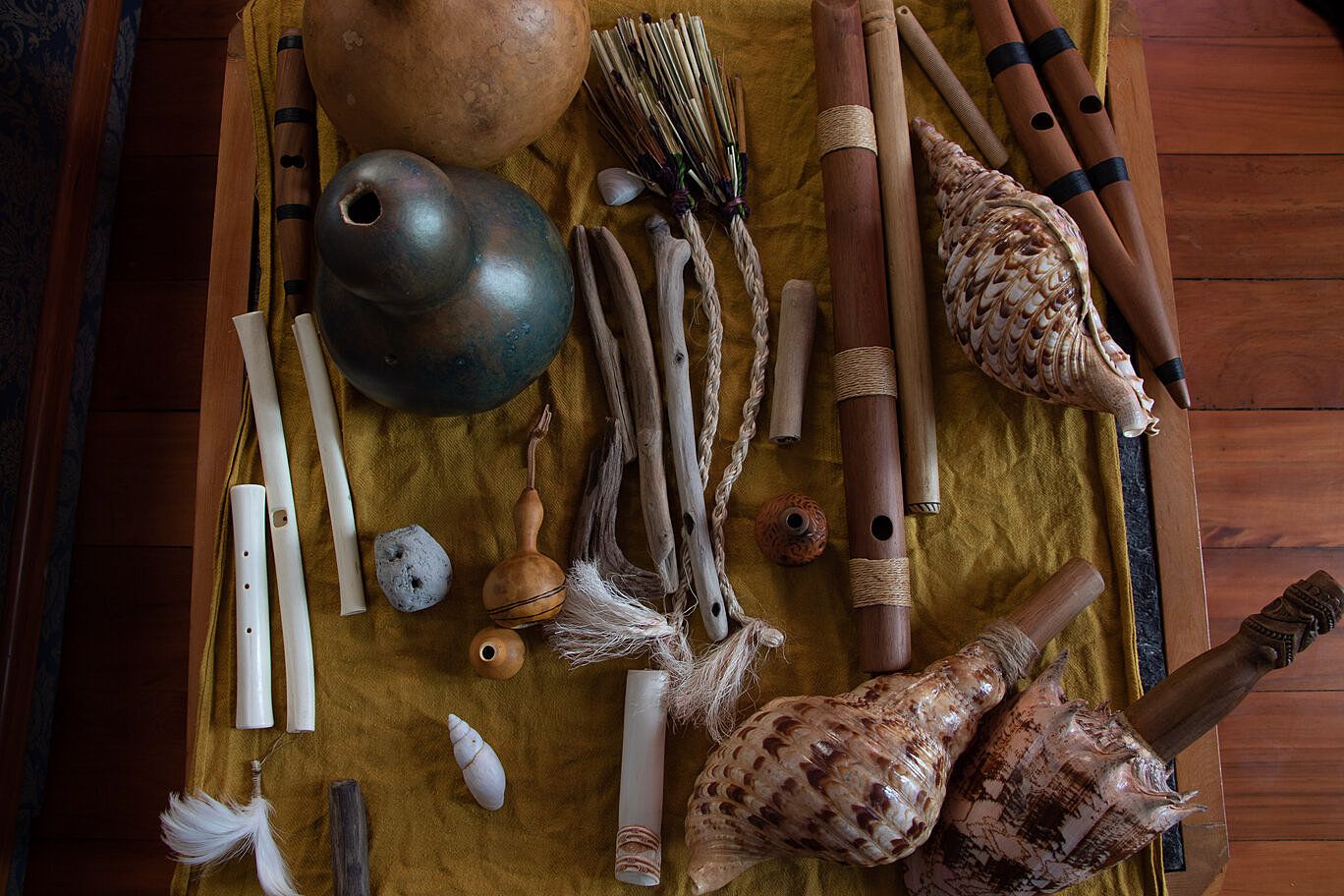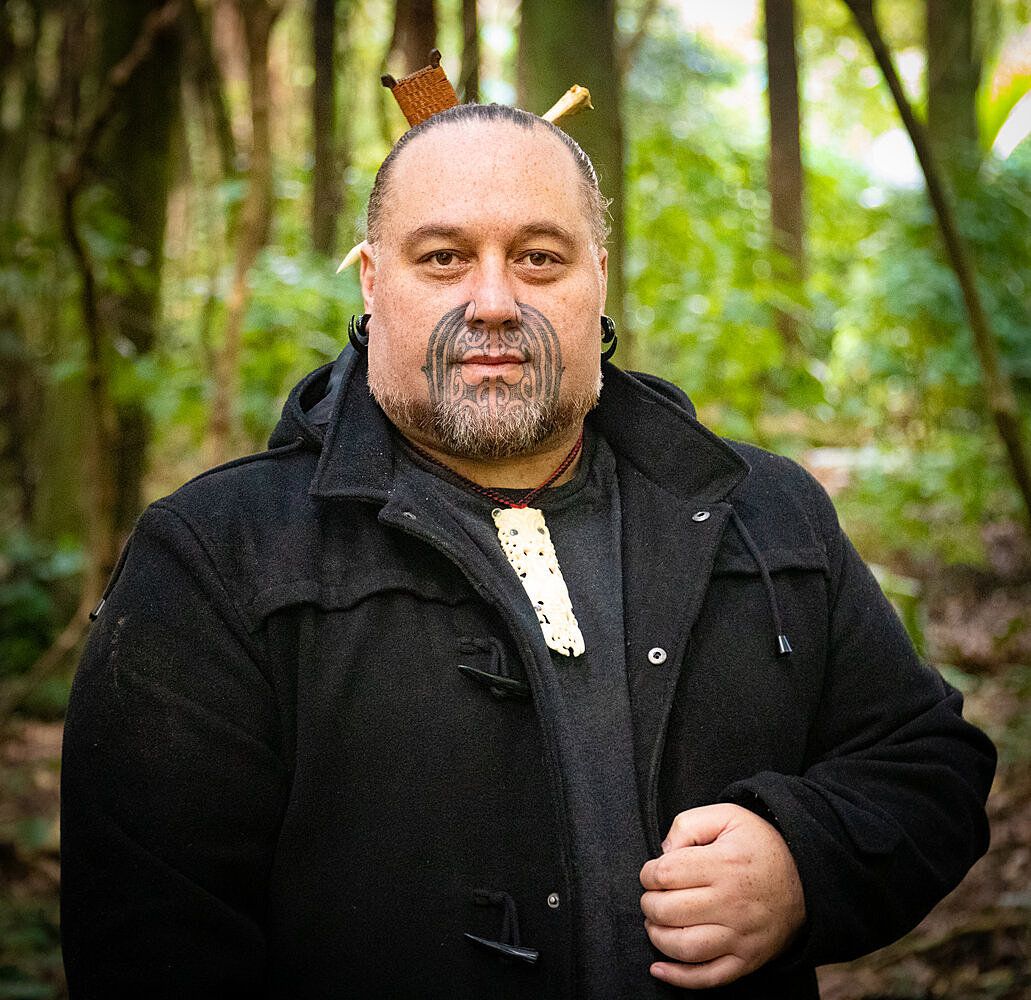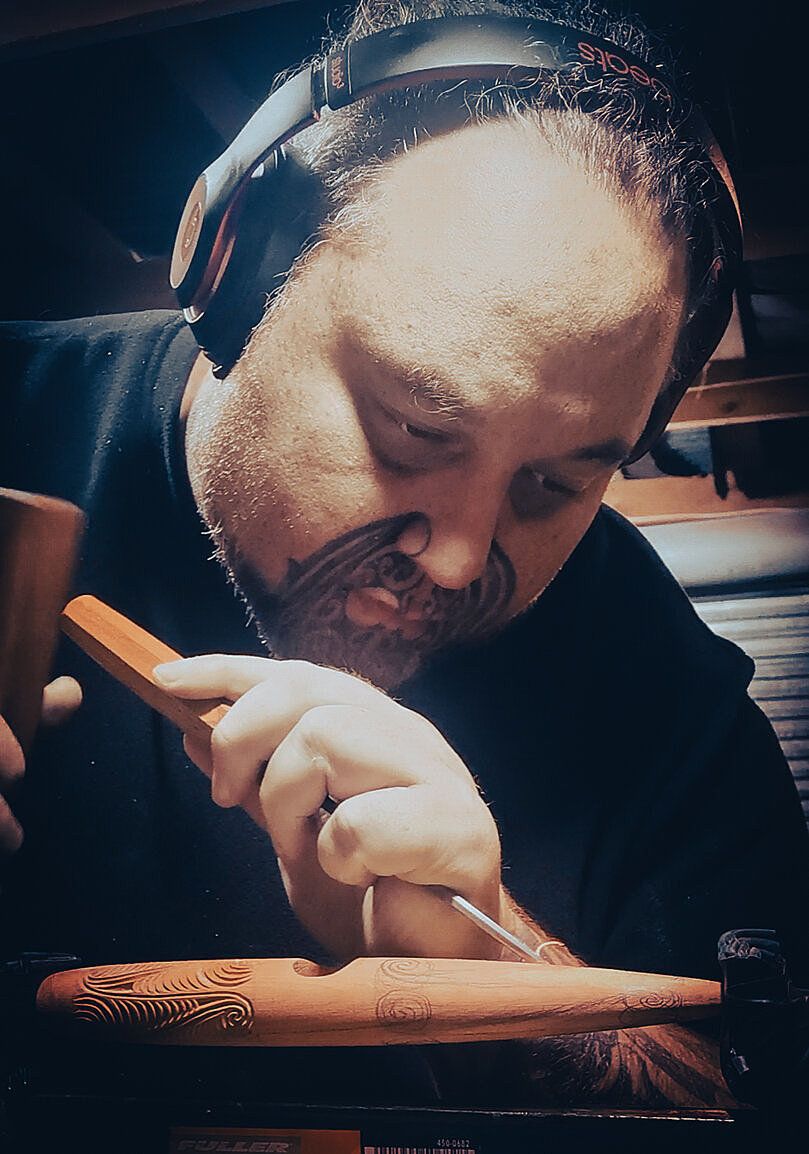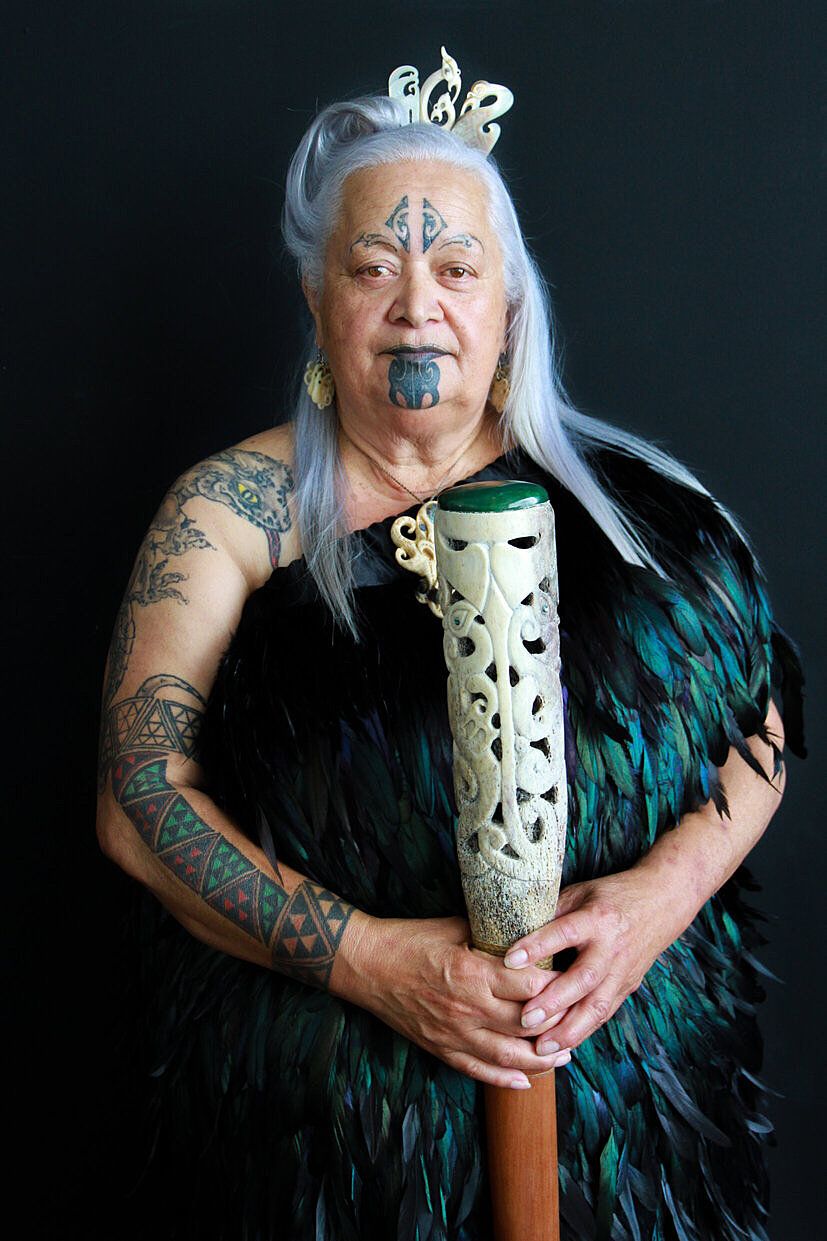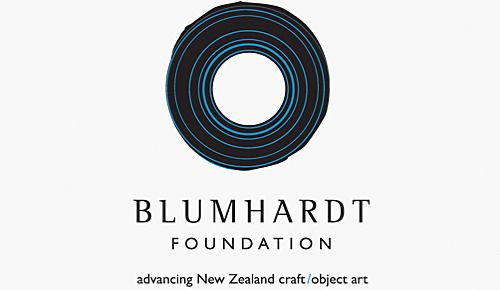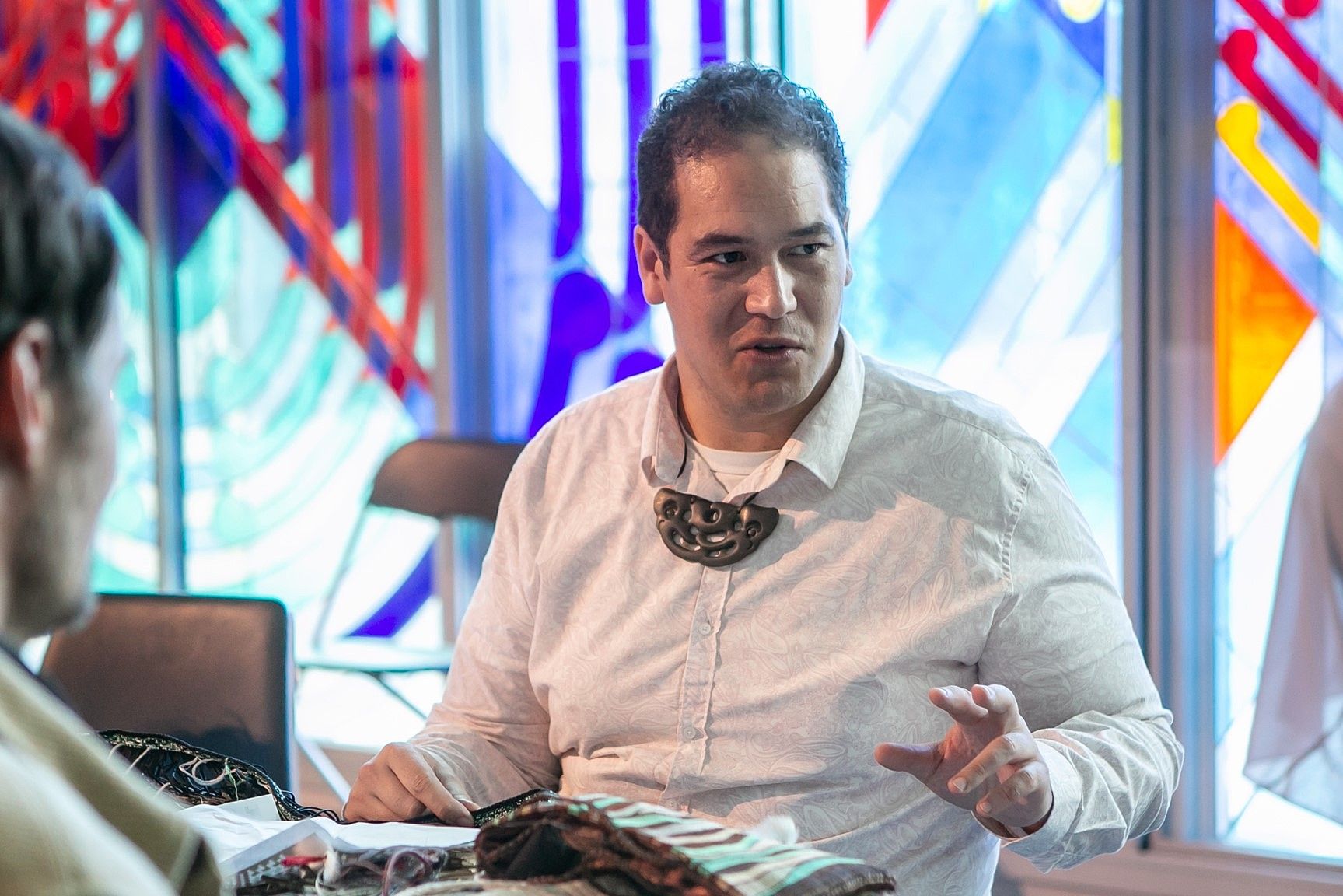Te Pū me te Oro: The Crafting of Taonga Pūoro
Khali Philip-Barbara, Tāmihana Kātene and Hinewirangi Kohu-Morgan with curator Isaac Te Awa on the making of taonga pūoro.
Every culture has a voice and in Te Ao Māori we have taonga pūoro.1 An extension of the voice of our people, taonga pūoro are intrinsically connected to our natural world and environment. Their use has been woven into the fabric of our communities for as long as we have existed. Taonga pūoro move us, teach us, connect us, inspire us and heal us. Taonga pūoro tell our stories.
Like many Māori cultural practices, taonga pūoro suffered greatly under the impacts of colonisation. The Tohunga Suppression Act 1907 forced the open practice of taonga pūoro underground, and by the time the Act was repealed in 1962, it was well on the way to being forgotten. In 1984 a hui was held at Te Araroa, in Te Tairāwhiti, to gather the remaining knowledge surrounding taonga pūoro. This set off sparks that ignited a revival joined by practitioners and enthusiasts from all walks of life. Leading the movement was the late Hirini Melbourne (Ngāi Tūhoe), the late Richard Nunns and Brian Flintoff, who travelled Aotearoa gathering information to return to the people, thus supporting and nurturing a new generation of players.
Thirty-seven years after its return to the people, taonga pūoro and its popularity has surged with Māori and non-Māori. Since the initial revival, the torch continues to be passed from one generation to the next as new knowledge and ideas are uncovered. The art of making and playing taonga pūoro has grown in not just numbers but also innovative practices stretching beyond the performance-based methods that were common during the revival.
To focus purely on the physical making of these taonga would not do justice to their complexity and meaning
More and more, we are seeing taonga pūoro used in a diverse range of practices across the spectrum of te ao Māori, including rongoā, pōwhiri, whaikōrero, karakia and the telling of pūrākau. They are also becoming more visible in other fields, such as therapy, education and Western music. Taonga pūoro is a living art form, and therefore subject to innovation and change.
In uncovering these innovations in crafting practices, I spoke to three makers and players of taonga pūoro: Khali Philip-Barbara, Tāmihana Kātene and Hinewirangi Kohu-Morgan. While my initial intention was to discuss the physical making and crafting of taonga pūoro, it quickly became apparent that these taonga are much more than the physical crafting of something aesthetically beautiful or that makes a sound. Taonga pūoro are a combination of a long whakapapa of making, a meaningful connection and awareness of objects in the environment, and a deep sense of knowing oneself. To focus purely on the physical making of these taonga would not do justice to their complexity and meaning.
Khali Philip-Barbara is a storyteller who draws on the continuum of toi Māori and pūrākau to amplify and advocate Māori narratives and ways of being
Khali Philip-Barbara playing pūoro, 2021. Photo by Jessie-Lee Robertson. Courtesy of He Kākano Ahau Podcast
Khali Philip-Barbara (Ngāti Porou, Ngāti Uepohatu) is a storyteller who draws on the continuum of toi Māori and pūrākau to amplify and advocate Māori narratives and ways of being. Khali is a Wellington-based performer who sings, raps and composes, drawing inspiration from the ability to listen to people and the natural world around her. Khali doesn’t just make and carve pūoro, she finds them, and they find her.
“I think that pūoro are anything that can make a sound. What makes pūoro unique or a practice is that it involves a person who has to connect with something to make a sound. Two kōhatu can be pūoro, but only because you have decided to explore their oro.2 So using this, we can turn anything into pūoro. Here, I’ll show you this one. This is a ceramic flower holder I found at an op shop. It took some hard work with a drill but I put some wenewene3 in it and now it’s a pōnga ihu.”4
“So many people are under the impression that you have to go to a shop (if you can find one) and buy beautifully carved expensive pūoro. I love to just go to the beach and find things. I love the surprises you get at the beach. Pūoro sound is different for different people, too. It’s about the mauri of the taonga and the individual. I think just giving yourself the time to be is important in allowing pūoro to come to you.
“I tell myself, I’m going to go to the beach. I’m going to find bones, and I’m going to make kōauau.5 It’s so freeing. A friend and I started with finding bones at the beach. After that, I started seeing hue in second-hand shops and have collected whatever kinds of lost potential pūoro I can find ever since. My friend calls me the ‘maker of obscure pūoro’.”
Khali Philip-Barbara and Ruby Solly’s taonga pūoro, 2021. Photo by Jessie-Lee Robertson. Courtesy of He Kākano Ahau Podcast
“My main message is that pūoro were a part of our environment. Our tīpuna were looking to what was already available to them. Pūoro aren't meant to be these huge and inaccessible things, and it's not about perfection.
“If you’re new to pūoro and you know nothing at all, and you ask me where you should go to learn, I will literally send you to the beach. Go to the beach. Listen to the waves. Select two kōhatu and see what happens. Connect with te taiao and ngā atua. As humans, we always look for easy things, the machine made and ready to go. We look in the wrong places. Looking, observing and listening. All of these things that are easy to do, you just have to make the time.”
For someone to truly be a player of taonga pūoro, te taiao and the atua must be central in the thoughts of the aspiring player and maker
For someone to truly be a player of taonga pūoro, the natural world, te taiao, and the atua must be central in the thoughts of the aspiring player and maker. There are over 44 different kinds of taonga pūoro that exist today, and the reality is that this number continues to grow, like the practice itself.
Not all pūoro are solely in their natural, found form. Some of the most exceptional are crafted and altered by carvers, weavers and artists. Core to the philosophy of taonga Māori is that the materials of the natural world have a whakapapa, a real connection to the atua from whom they descend. For example, all things made of wood descend from Tāne, the atua and father of the trees and forest. When Māori take materials from the natural world to create, we adorn them to pay homage and respect this connection.
This is evidenced by the exemplary taonga pūoro left for us by our tūpuna in museums and collections. All of these pūoro contain decorative elements; a carving, an etching, a binding, a feather, or a shaped form recognising and paying homage to the atua and environment to which it remains connected. These taonga continue to inspire makers today.
Tāmihana Kātene has dedicated his life to the continuation and re-creation of classic taonga pūoro
Tāmihana Kātene, 2021. Courtesy of Tāmihana Kātene
For over 20 years, Tāmihana Kātene (Ngāti Toa Rangatira, Ngāti Tama, Ngāti Koata, Ngāti Whātua) has been a maker, player and advocate of taonga pūoro. The Porirua-based carver of wood, stone and bone has dedicated his life to the continuation and re-creation of classic taonga pūoro, specifically those created prior to contact with Europeans. These pūoro differ from those made today, due to the introduction of European woodworking tools such as saws and modern glues, which allow for the rapid shaping and joining of wood. Before this, naturally shaped wood had to be found in the forest, carefully split and hollowed with stone tools before being lashed and bound with naturally occurring saps and materials. While a slower process than today, it ultimately produced a much more refined pūoro. Tāmihana has learnt from a variety of skilled mentors as well as from taonga held in museum collections. For Tāmihana, taonga pūoro isn’t a skill set; it’s a lifelong journey of self.
“The first taonga pūoro I played was the pūmoana6 when I was seven years old, but it wasn’t until I was in my 20s that I really started to explore. I wasn’t a carver back then and I didn’t know how to make or have the skills to make anything. So my first pūoro was an asthma inhaler.
An asthma inhaler may sound strange, but taonga pūoro can be just about anything
“An asthma inhaler may sound strange, but taonga pūoro can be just about anything, so long as the thought process and philosophy behind this is Māori. One of the tikanga I love about pūoro is that they are made for the people playing them. No one knows you better than you.
“Every pūtōrino7 that I have ever made, the next one is a little bit different, and then the next one is a little bit different to that. I don’t mean the aesthetics of how it’s carved; I mean the mechanics. Many modern taonga pūoro were made as trophy pieces. They were made to look beautiful and not to sing. The problem with creating taonga pūoro to sing is that you have to be guided by someone who knows what they’re doing and use those guidelines as a framework.
“For my first five years making pūtōrino, I forced myself not to carve the outside. The focus was always on learning the inside of the pūtōrino. What works. What doesn’t work. Sizes, proportions, ratios. What came out of that learning process is pūtōrino that play really well. They are easier to produce a sound from, and this sound is sweeter, with a greater range of notes. These pūtōrino sing.”
Tāmihana Kātene carving a pūtōrino, 2021. Courtesy of Tāmihana Kātene
“Other carvers – and there are many amazing carvers across the motu – focus on the art of carving. This is an absolute beautiful thing, and they apply what they know to what they make. But unless you’ve learnt the mechanical thought process regarding taonga pūoro and the oro, you will only make a beautifully carved taonga.
“One of the saddest things I’ve experienced as a practitioner of pūoro is seeing a stunningly carved pūtōrino that doesn’t play. Well, let’s not say it doesn’t play, but if I’ve had 20 years of experience and I can’t make them sing or make any sound, what message does that send to a learner or beginner who should be enjoying the process of learning to play? Pūtōrino that are made properly, with the oro as the focus, are easy to play.
“I am happy, though, because there is now a new generation of carvers who focus on the oro, and their numbers are growing. The more they make, the more examples there are of beautifully carved taonga pūoro that also play, and this is something we need more of.”
Totara wood pūtōrino carved by Tāmihana Kātene, 2021. Courtesy of Tāmihana Kātene
The term taonga pūoro is frequently translated as ‘Māori instruments’, but to those who practice taonga pūoro, the word instrument doesn’t begin to describe or capture what they do. Depending on the player, the intention and breadth of taonga pūoro also encompass healing, pūrākau, storytelling and ceremony.
For many people who lack verbal words in English or te reo Māori, taonga pūoro provide access to a voice that allows them to express their emotions, and connect to others and the environment around them. These taonga and their oro, their voices, were once integrated into all levels of Māori society. As the numbers of practitioners and makers increase, we see a visible return to this in Aotearoa today.
Hinewirangi Kohu-Morgan is lovingly and respectfully called ‘Nan’. She is the kaumatua many Māori never had growing up
Hinewirangi Kohu-Morgan, 2020. Courtesy of Soldiers Rd Portraits
Within the pūoro community, Hinewirangi Kohu-Morgan (Ngāti Porou, Ngāti Kahungunu ki Nuhaka, Ngāti Ranginui ki Tauranga Moana) is lovingly and respectfully called ‘Nan’. She is the kaumatua many Māori never had growing up, and gently passes knowledge to the next generation like only one who has truly lived can. She is also a poet, writer, activist, artist and everything in between. For Hamilton-based Hinewirangi, pūoro isn’t just about sound. It’s about our connection to our environment. This includes the physical and non-physical world, but more importantly, it’s about knowing yourself.
“I have always played pūoro, ever since I was a kid. We didn’t have TV or anything like that when I was growing up, so we learnt to sing and write songs. We played everything around us. We played combs, spoons, sticks, shells from the beach; it all started with the oro or the voice. We didn’t have a word for taonga pūoro then, but they were everywhere. It’s something that was, and it didn’t need a name. It was just who we were.
Taonga pūoro aren’t instruments, they are taonga. They don’t just make sounds; they have voices that say things
“I enjoy the natural world, and pūoro are part of the natural world. There are a lot of pūoro out there made by people who don’t play them. Because of that, their pūoro don’t play well. Stop rushing. Slow down. Taonga pūoro aren’t instruments, they are taonga. They don’t just make sounds; they have voices that say things. Every taonga pūoro played by someone says something, and every taonga pūoro made was made to say something.
“Taonga pūoro isn’t just about playing things around you. It’s about you, your self, and your life. Pūoro are part of your whole being. Before you play a note or make a sound on any pūoro, you have to think about it. You have to think of every note in your head before you can make it sound out loud with your breath into the world. The most important pūoro you need to learn to play in your life isn’t the one you hold in your hand. It’s yourself.”
Through connecting to the mauri held in taonga that are old, makers channel and rebirth this mauri into new taonga
As someone who works with taonga Māori every day, it has been impossible for me not to notice the increase in demand for mātauranga surrounding taonga pūoro. To be Māori is to understand that mauri is the essence and force that animates all things in the universe. As a practitioner myself of raranga and whakairo, I believe that understanding comes from the skilled knowledge of makers that carry the living mauri of their art forms.
Through connecting to the mauri held in taonga that are old, makers channel and rebirth this mauri into new taonga that continue to live and connect with those around them. This belief has inevitably led me on my own pūoro journey to start to explore what these taonga mean to the people who live, breathe, play and create them. Though I have barely begun, I have been fortunate enough to be surrounded and mentored by the diverse people who make up the taonga pūoro whānau and community. As I move through the layers of meaning on the path before me, on what will undoubtedly be a lifelong journey, it is a journey I know I will not have to take alone.
1 Taonga pūoro:Frequently translated as ‘Māori musical instruments’, which is misleading as it doesn’t capture their diverse use. While taonga pūoro can produce music, they are also used in ceremony, healing, teaching, storytelling and meditation.
2 Oro: Sound, voice, echo or resonate.
3 Wenewene: Hole or finger hole in a taonga pūoro. Used to emphasise or change the sound.
4 Pōnga ihu: Hollow taonga pūoro, usually played with the breath from the nose. Most are made from hue but other materials are used.
5 Kōauau: Taonga pūoro often compared to a flute. Usually made from bone or wood. May contain wenewene.
6 Pūmoana: Taonga pūoro made from a species of conch shell. Likened to a trumpet.
7 Pūtorino: A taonga pūoro customarily made from wood, based on the case of the moth cocoon. Often likened to a combination of a flute and bugle/trumpet but in truth, it is neither and is unique to Māori.
Translations and definitions in the footnotes are sourced from Te Aka Māori Dictionary.
*
This piece is presented as part of a partnership with Blumhardt Foundation. They cover the costs of paying our writers while we retain all editorial control.
Feature image: Khali Philip-Barbara playing hue, 2021. Photo by Jessie-Lee Robertson. Courtesy of He Kākano Ahau Podcast

